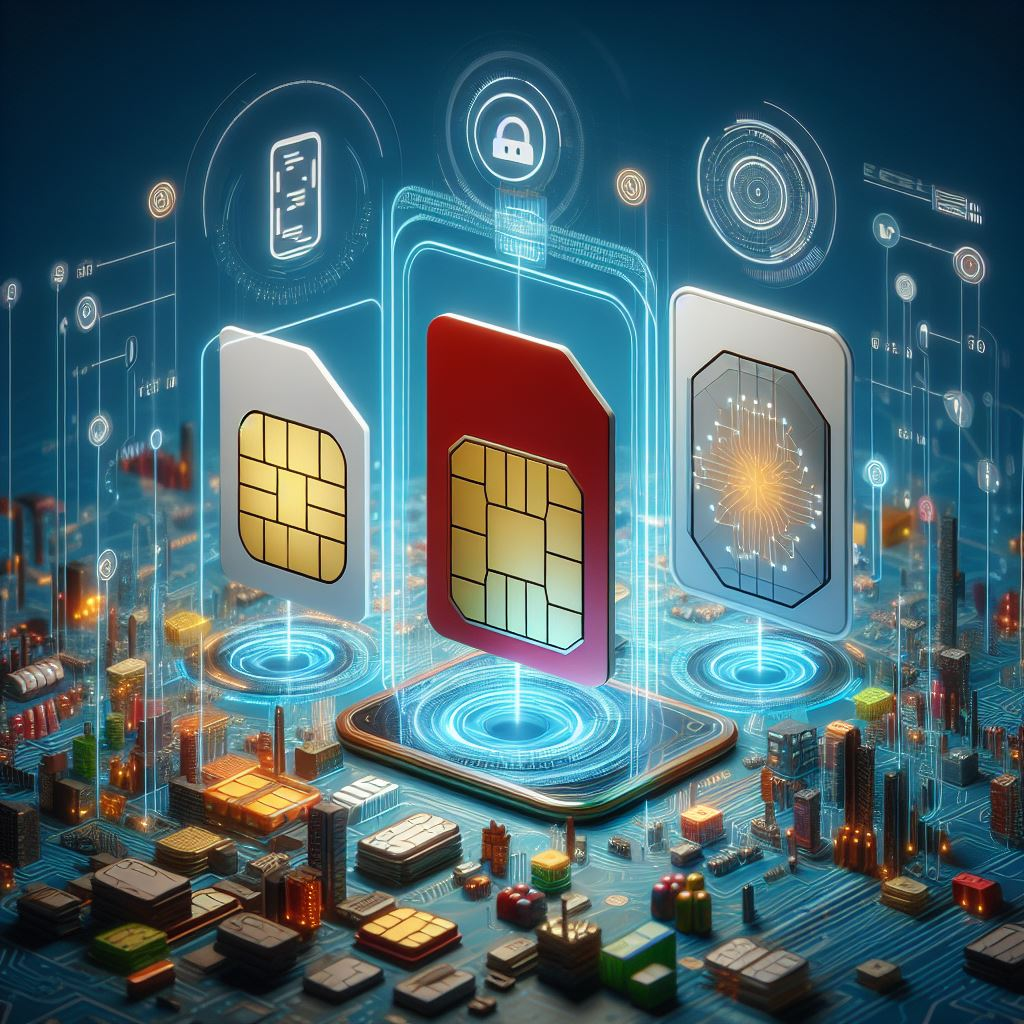Starting eSIM Data Plan
Published by
Jan 17 2024

eSIM Data Plans: What You Need to Know

A person holding a smartphone displaying a list of eSIM data plans on the screen.
eSIM Data Plans are becoming increasingly popular as more mobile devices support this technology. These plans offer a convenient and flexible way to access mobile data without the need for a physical SIM card. To help you navigate through the world of eSIM Data Plans, here are some key aspects you need to know.
Firstly, starting with eSIM Data Plans is simple and hassle-free. Instead of purchasing a physical SIM card, you can activate your eSIM by scanning a QR or confirmation code provided by your carrier. This QR code contains the necessary information to set up your eSIM and connect to your carrier’s network. Once the eSIM activation is complete, you can enjoy all the functionalities of a traditional cellular data network without the inconvenience of inserting and removing a physical SIM card.
Secondly, it’s crucial to understand the difference between eSIM activation and eSIM carrier activation. When users activate eSIM cards, they are simply configuring the eSIM profile on their device to connect to a specific carrier’s network.
On the other hand, carrier activation refers to the process of signing up for a data plan with a specific carrier. While eSIM activation allows you to use the device with multiple carriers, you still need a valid data plan from a carrier to access mobile data. Therefore, it’s important to research and select the right eSIM carrier that offers suitable data plans to meet your specific needs. By doing so, you can avoid any potential compatibility issues and ensure a seamless experience in managing your mobile data.
With these key insights, you are now equipped with a better understanding of eSIM Data Plans. In the next sections of this article, we will delve deeper into the basics of eSIM technology, explore its differences from traditional SIM cards, and discuss the benefits of using eSIM Data Plans. By gaining a comprehensive knowledge of eSIM technology, you can make informed decisions when it comes to activating eSIM Data Plans and choosing the right data plan for your needs.
Understanding the Basics of eSIM Technology
eSIM, also known as embedded SIM, is a revolutionary technology that has transformed the way we use cellular data and manage our mobile devices. Unlike traditional SIM cards that need to be physically inserted into a device’s SIM tray, eSIM is embedded directly into the device’s hardware. This means that users no longer need to deal with physical SIM cards or worry about misplacing them.
With eSIM, activating your cellular plan becomes a seamless process. Instead of going through the hassle of inserting a physical SIM card and waiting for it to be activated, you can easily activate your eSIM by simply scanning a QR code or entering an activation code provided by your mobile data plan provider. This eSIM quick transfer not only saves time but also ensures a hassle-free experience for users.
One of the significant advantages of eSIM technology is the ability to have a dual SIM functionality on a single device. This means that users can have two separate cellular data plans on their device, eliminating the need to carry multiple devices or constantly switch SIM cards. Whether you need one SIM for personal use and another for work or if you frequently travel abroad and require a local mobile data plan, eSIM provides the flexibility to easily manage and switch between different plans without any physical intervention.
How eSIM Differs from Traditional SIM Cards

Evolving Connectivity: Traditional SIM vs. eSIM.
eSIM, or embedded SIM, is a digital SIM card that comes built into compatible devices such as new iPhone models. Unlike traditional SIM cards that need to be physically inserted into the device’s SIM card slot, eSIM allows users to activate cellular plans without the need for a physical SIM card. This advancement in technology brings several notable differences in terms of ease of use and flexibility.
One significant difference between eSIM and traditional SIM cards is the activation process. With eSIM, you can easily activate a cellular plan by accessing their iPhone’s settings and navigating to the “Cellular” section, then tap “Add Cellular Plan.” This streamlined process eliminates the hassle of physically inserting and removing SIM cards from the device, making it more convenient for users to switch between different cellular plans when needed.
Another difference is the integration of eSIM into the iPhone’s built-in features. For instance, users can assign a specific cellular plan to their camera app, allowing them to seamlessly switch between different data plans based on their needs. This level of integration demonstrates how eSIM brings a new level of flexibility and convenience to iOS device users.
Overall, the introduction of eSIM technology has revolutionized the way we connect and manage cellular plans on our devices. The seamless activation process and integration into various applications make it evident that eSIM is here to stay. As more devices become eSIM compatible and more cellular providers offer eSIM data plans, it will be interesting to see how this technology continues to reshape the mobile industry.
Benefits of Using eSIM Data Plans
eSIM data plans offer a range of benefits for tech-savvy individuals seeking a seamless and hassle-free connectivity experience. When setting up an eSIM, users can conveniently follow the on-screen instructions provided by their device manufacturer or cellular provider. Unlike traditional SIM cards, eSIMs eliminate the need for physical cards and allow users to activate a secondary or primary SIM profile directly on their device.
One notable advantage of eSIM data plans is the flexibility they offer. With an eSIM, users can easily switch between different carriers and select the most suitable data plan for their needs, without the hassle of physically swapping SIM cards. Various carriers support eSIM technology, making it easier than ever to find a plan that fits your requirements. Compatible devices, such as the iPhone XS, are equipped with eSIM capability, allowing users to set up and manage their eSIM information manually.
Furthermore, eSIMs provide the convenience of having multiple phone numbers on a single device. This is particularly advantageous for individuals who travel frequently or need separate numbers for personal and professional purposes. With an eSIM-compatible device, users can have separate data plans and phone numbers, eliminating the need to carry multiple handsets or constantly swap out SIM cards. The ability to manage and monitor data usage on the go adds another layer of convenience, ensuring that users can stay connected without worrying about exceeding their data limits.
eSIM Activation Process

QR Magic: Activating eSIM with a simple scan.
To activate an eSIM data plan on your device, you will need a stable Wi-Fi connection and the verification code provided by your mobile network provider. Unlike traditional SIM cards, eSIMs allow you to have multiple cellular plans on one device, eliminating the need for physical SIM card swapping. Here are step-by-step instructions on how to activate your new eSIM data plan.
First, ensure that your device is connected to a Wi-Fi network. This is necessary for the initial setup and activation process. Next, locate the eSIM information provided by your mobile network provider. This could be in the form of a QR code or a numerical code. On your device, go to Settings, then select Cellular. Tap on Add Cellular Plan and follow the prompts to scan the QR code or enter the code manually. Once the code is recognized, your eSIM data plan will be activated, and you can start using it alongside your other cellular plans.
It’s important to note that activating an eSIM data plan may differ slightly depending on your mobile network provider or device model. If you encounter any issues, your provider may be able to guide you through the process or offer alternative methods of activation. In any case, having an eSIM on your device allows for greater flexibility and convenience when it comes to managing your cellular plans.
Compatible Devices for eSIM Data Plans
eSIM technology offers a convenient alternative for users who want to stay connected without the hassle of physical SIM cards. With eSIM, compatible devices can easily switch between multiple carriers and data plans without needing to swap out SIM cards. For those in need of a new device, it is important to ensure that it supports eSIM functionality.
Before diving into the world of eSIM data plans, it is crucial to check if your device is compatible. Most newer smartphones and tablets are eSIM-compatible, but it is always advisable to verify this information before making a purchase. Once you have a compatible device, activating an eSIM data plan is relatively simple. In most cases, you can set up an eSIM by scanning a QR code provided by your chosen carrier or following the activation steps on their website or app. This enables you to easily switch between different data plans, whether for domestic use, traveling abroad, or exploring options from other carriers. Furthermore, eSIM capabilities allow you to conveniently toggle between Wi-Fi and cellular data options, ensuring a seamless browsing experience no matter where you are.
Choosing the Right eSIM Data Plan for Your Needs

Data Plan Showcase: Explore a spectrum of eSIM options.
When it comes to choosing the right eSIM data plan for your needs, it’s important to consider several factors. First and foremost, you need to ensure that your device is compatible with eSIM technology. Currently, popular devices like iPhone and Google Pixel support eSIM functionality, allowing you to activate an eSIM data plan without the need for a physical SIM card.
Next, you should evaluate the data requirements of your day-to-day activities. If you rely heavily on data-intensive tasks such as streaming videos, downloading large files, or participating in online gaming, you’ll need a data plan that offers ample data allowances. On the other hand, if your data usage is relatively minimal, you can opt for a more cost-effective plan with lower data limits.
Another crucial factor to consider is the coverage area and availability of your preferred carrier. While eSIM technology offers the flexibility to switch between carriers, it’s essential to check if your chosen carrier provides reliable network coverage in your area. Additionally, if you travel frequently or plan to use your device in other countries, you should ensure that your eSIM data plan offers international roaming options.
To choose the right eSIM data plan, you need to activate it on your phone. The process typically involves scanning a QR code provided by your carrier through the eSIM settings on your device. Once activated, you can enjoy the benefits of eSIM technology, such as the ability to switch between different eSIM data plans without needing to physically switch out SIM cards.
In conclusion, selecting the right eSIM data plan requires careful consideration of device compatibility, data requirements, carrier coverage, and the activation process. By taking these factors into account, you can tailor your eSIM data plan to perfectly suit your needs and preferences.
Managing and Monitoring Your eSIM Data Usage
To effectively manage and monitor your eSIM data usage, it is essential to familiarize yourself with the code required to access and control your data settings. Each cellular carrier may have a unique code that you need to enter into your device to access the eSIM settings. Consult your carrier’s website or contact their customer support for the specific code relevant to your network.
Once you have obtained the necessary code, navigating to the eSIM settings on your compatible device is the next step. Ensure that your device is unlocked and has the latest software updates installed. From there, you can proceed to install and set up your eSIM data plan by following the prompts and entering the required information, such as your carrier network and activation code. It is crucial to enter the details accurately to ensure a seamless activation process.
Furthermore, monitoring your eSIM data usage is vital to avoid exceeding your allocated data limits or incurring additional charges. Most devices offer built-in tools or applications that allow you to track your data usage. These tools typically provide real-time updates on how much data you have consumed, allowing you to adjust your usage accordingly. Additionally, you can set up notifications or alerts to receive warnings when you are nearing your data limit. By actively managing and monitoring your eSIM data usage, you can make informed decisions on how to best optimize your data plan and avoid any unexpected costs.
Troubleshooting Common Issues with eSIM Data Plans
When using eSIM data plans, it is not uncommon to encounter some common issues that may require troubleshooting. One of the first steps in troubleshooting is to check your device settings. Ensure that the eSIM is properly activated and set as the primary SIM card. To do this, navigate to the settings menu on your device and select the “Cellular” or “Mobile Data” option. From there, you should be able to locate the eSIM settings. If the eSIM is not appearing or if you are experiencing any issues with activation, it is recommended to follow the specific instructions provided by your device manufacturer.
If you are using an iPhone with an eSIM, you can also troubleshoot common issues through the Apple Watch app. Open the app, go to the “My Watch” section, and select “Cellular”. From there, you can verify that your eSIM is properly connected and activated. If you are unable to connect to the cellular network or experience any difficulties, it may be helpful to restart your device or reset network settings in the “General” section of the device settings menu. Additionally, make sure that you have the latest version of iOS installed, as software updates often include improvements and bug fixes for eSIM functionality.
FAQs

Dive In: Commencing the eSIM Data Plan Journey.
What is an eSIM data plan?
An eSIM data plan is a digital SIM card that allows you to access cellular data on your device without the need for a physical SIM card.
What are the benefits of using eSIM data plans?
Some benefits of using eSIM data plans include the ability to switch between different plans easily, no need to physically insert or remove SIM cards, and the convenience of managing your data plans directly on your device.
How do I activate an eSIM data plan?
To activate an eSIM data plan, you will typically need to scan a QR code provided by your mobile carrier and follow the instructions on your device to set it up.
Which devices are compatible with eSIM data plans?
Many newer smartphones, tablets, smartwatches, and laptops are compatible with eSIM data plans. It’s best to check with your device manufacturer or mobile carrier to confirm compatibility.
How do I choose the right eSIM data plan for my needs?
When choosing an eSIM data plan, consider factors such as data allowance, coverage, pricing, and any additional features or perks offered by the mobile carrier. It’s important to evaluate your data usage patterns and requirements to ensure you select a plan that suits your needs.
How can I manage and monitor my mobile data usage?
Most devices offer built-in tools to manage and monitor your eSIM data usage. You can typically find these settings in the device’s network or settings menu. Additionally, some mobile carriers may offer dedicated apps or online portals to help you track and manage your data usage.
What are some common issues with eSIM data plans?
Some common issues with eSIM data plans include activation failures, connectivity problems, compatibility issues with certain devices or carriers, and difficulty in switching between eSIM data plans. Troubleshooting these issues may require contacting your mobile carrier for assistance.
How can I troubleshoot common issues with eSIM data plans?
If you encounter issues with your eSIM data plan, try restarting your device, ensuring that the eSIM is properly activated, checking for software updates, and contacting your mobile carrier for further assistance. They may be able to provide troubleshooting steps specific to your device and plan.

